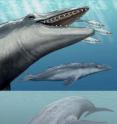Molecular decay of enamel-specific gene in toothless mammals supports theory of evolution
Related images
(click to enlarge)
Biologists at the University of California, Riverside report new evidence for evolutionary change recorded in both the fossil record and the genomes (or genetic blueprints) of living organisms, providing fresh support for Charles Darwin's theory of evolution. The researchers were able to correlate the progressive loss of enamel in the fossil record with a simultaneous molecular decay of a gene, called the enamelin gene, that is involved in enamel formation in mammals.
Enamel is the hardest substance in the vertebrate body, and most mammals have teeth capped with it.
Examples exist, however, of mammals without mineralized teeth (e.g., baleen whales, anteaters, pangolins) and of mammals with teeth that lack enamel (e.g., sloths, aardvarks, and pygmy sperm whales). Further, the fossil record documents when enamel was lost in these lineages.
"The fossil record is almost entirely limited to hard tissues such as bones and teeth," said Mark Springer, a professor of biology, who led the study. "Given this limitation, there are very few opportunities to examine the co-evolution of genes in the genome of living organisms and morphological features preserved in the fossil record."
In 2007, Springer, along with Robert Meredith and John Gatesy in the Department of Biology at UC Riverside, initiated a study of enamelless mammals in which the researchers focused on the enamelin gene. They predicted that these species would have copies of the gene that codes for the tooth-specific enamelin protein, but this gene would show evidence of molecular decay in these species.
"Mammals without enamel are descended from ancestral forms that had teeth with enamel," Springer said. "We predicted that enamel-specific genes such as enamelin would show evidence in living organisms of molecular decay because these genes are vestigial and no longer necessary for survival."
Now his lab has found evidence of such molecular "cavities" in the genomes of living organisms. Using modern gene sequencing technology, Meredith discovered mutations in the enamelin gene that disrupt how the enamelin protein is coded, resulting in obliteration of the genetic blueprint for the enamelin protein.
Results of the study appear in the Sept. 4 issue of the open-access journal PLoS Genetics.
Darwin argued that all organisms are descended from one or a few organisms and that natural selection drives evolutionary change. The fossil record demonstrates that the first mammals had teeth with enamel. Mammals without enamel therefore must have descended from mammals with enamel-covered teeth.
"We could therefore predict that nonfunctional vestiges of the genes that code for enamel should be found in mammals that lack enamel," Springer said. "When we made our predictions, however, we did not have sequences for the enamelin gene in toothless and enamelless mammals. Since then my lab worked on obtaining these sequences so we could test our prediction."
Previous studies in evolutionary biology have provided only limited evidence linking morphological degeneration in the fossil record to molecular decay in the genome. The study led by Springer takes advantage of the hardness of enamel and teeth to provide more robust evidence for the linkage.
"The molecular counterpart to vestigial organs is pseudogenes that are descended from formerly functional genes," Springer explained. "In our research we clearly see the parallel evolution of enamel loss in the fossil record and the molecular decay of the enamelin gene into a pseudogene in representatives of four different orders of mammals that have lost enamel."
Broadly, the research involved the following steps: First, Meredith collected the DNA sequences for the enamelin gene in different mammals. Next, the researchers analyzed sequences using a variety of molecular evolutionary methods, including new approaches developed by Springer's group. Finally, the group used the results of their analyses to test previous hypotheses and generate new ones.
"Currently, we are actively engaged in deciphering the evolutionary history of other genes that are involved in enamel formation," Springer said.
Source: University of California - Riverside
Other sources
- Molecular Decay Of Enamel-specific Gene In Toothless Mammals Supports Theory Of Evolutionfrom Science DailyMon, 7 Sep 2009, 5:32:28 UTC
- Molecular decay of enamel-specific gene in toothless mammals supports theory of evolutionfrom PhysorgFri, 4 Sep 2009, 13:07:05 UTC
- Molecular decay of enamel-specific gene in toothless mammals supports theory of evolutionfrom Science BlogFri, 4 Sep 2009, 3:56:09 UTC
- Molecular decay of enamel-specific gene in toothless mammals supports theory of evolutionfrom Science BlogFri, 4 Sep 2009, 1:21:07 UTC
